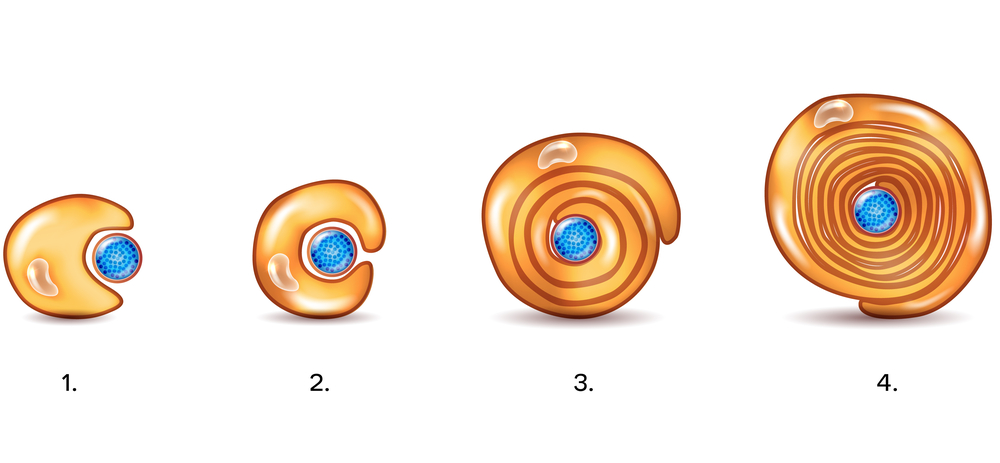Small Molecule Linked to Cells That Control Myelin Production and Repair in Study
Written by |

The formation of new myelin sheaths by oligodendrocytes is impaired in the absence of a small molecule, called Vav3, that oversees pathways regulating the shape of oligodendrocytes, new study reports.
Its researchers pinpoint Vav3 as a potential therapeutic target to improve and speed myelin repair in diseases like multiple sclerosis (MS).
Their study, “The guanine nucleotide exchange factor Vav3 modulates oligodendrocyte precursor differentiation and supports remyelination in white matter lesions,” was published in the journal Glia.
Myelin, the fat-rich substance that wraps around nerve fibers (axons), works to insulate and increase the velocity of signals relayed by nerve cells. Myelin loss is the underlying cause of diseases like MS.
Oligodendrocytes are myelin-producing cells, and those responsible for myelinating the nerve cells’ axons — a single oligodendrocyte is capable of myelinating multiple axons.
Mature, myelin-producing oligodendrocytes develop from more immature, stem cell-like cells that are called oligodendrocyte progenitor cells. These are the cells that, upon myelin loss, travel to demyelinated lesion sites where they will mature and generate myelin-producing cells.
Previous studies have shown that for myelin to be produced, oligodendrocytes need to undergo changes in their morphology (shape).
“In order for the insulation layer to be generated, the cell shape and its membrane extensions require complex changes,” Andreas Faissner, a professor at Ruhr-Universität Bochum, Germany and the study’s lead author, said in a press release.
Faissner’s team analyzed the molecular players that regulate the shape of oligodendrocytes.
The team focused on the guanine nucleotide exchange factor Vav3, a small molecule that oversees and regulates other molecules important for maintaining the cells’ shape. Vav3 is thought to have important functions in nerve cells of the central nervous system. However, its role in oligodendrocytes was unknown.
The Multiple Sclerosis News Today forums are a place to connect with other patients, share tips and talk about the latest research. Join today!
Researches used a mouse model engineered to lack Vav3. Test results showed that oligodendrocyte precursor cells in the absence of Vav3 matured faster into oligodendrocytes, but the number of mature oligodendrocytes was much lower in the area that connects the two sides of the brain, called corpus callosum.
Further experiments using cells in the lab found that oligodendrocytes lacking Vav3 had a poorer ability to produce myelin and to remyelinate damaged nerve cells. These in vitro (lab) findings were confirmed in vivo using a mouse model of MS — the animals were fed with cuprizone, a copper-binding toxin that kills oligodendrocytes and causes demyelination in brain areas such as the corpus callosum.
“We hope we’ve identified a potential approach for accelerating myelin repair with pharmacological means,” Faissner said. “Combined with our understanding of how important the Vav3 exchange factor is, it might be possible in future to control the molecular switches in such a way as to accelerate the regeneration of the myelin sheath.”
Results pinpoint “Vav3 as a novel regulator of oligodendrocyte maturation and remyelination, suggesting that manipulation of the Vav3‐dependent signalling pathway could help to improve myelin repair,” the study concluded.





